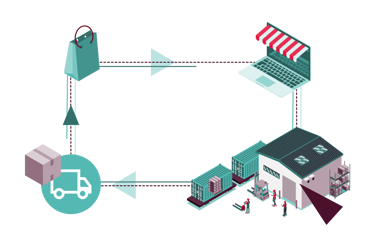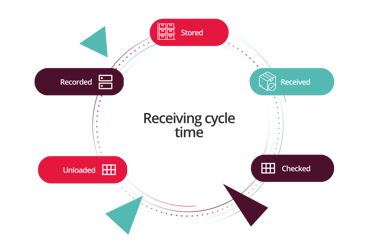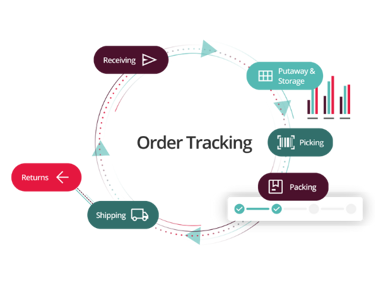14 Important Warehouse KPIs For Improved Operations (2024)
As a warehouse manager, you’ll know how important it is to run a smooth and efficient operation. To do this, it is essential to regularly monitor and review performance through your warehouse KPIs (key performance indicators). Warehouse KPIs analyse a specific process or operation and give you regular results that can be compared to understand how well that process is performing and take steps to improve if required.
Assessing warehouse operations with the use of KPIs allows you to easily benchmark performance to keep track of trends, gauge efficiency across all areas, uncover potential bottlenecks, manage risk, and much more.
Despite each warehouse having unique functions and operations, the KPIs discussed in this guide can be applied to almost all warehouse settings. You likely won’t need to use every warehouse KPI to achieve your business goals. Instead, select the ones that are most relevant to your operations and objectives.
Introduction to warehouse KPIs
We’ve divided the 14 warehouse KPIs discussed in the guide into 4 separate areas of warehouse operation: inventory, receiving, putaway, and order management.
Jump to:
Warehouse inventory KPIs
Inventory turnover
Carrying cost of inventory
Inventory to sales ratio
Shrinkage
Warehouse receiving KPIs
Receiving efficiency
Receiving cycle time
Warehouse putaway KPIs
Putaway accuracy rate
Putaway cycle time
Warehouse order management KPIs
Picking accuracy
Rate of return
Backorder rate
Order lead time
Total order cycle time
Fulfilment accuracy rate
Warehouse inventory KPI examples
Warehouse inventory KPIs relate to the stock of products you have stored in your warehouse. They are the best way of monitoring how your inventory is moving and covers areas such as turnover, carrying cost, inventory-to-sales ratio, as well as shrinkage.
1. Inventory turnover
Inventory turnover is the frequency at which you sell out your inventory. In other words, how quickly stock is sold and shipped. A higher value suggests strong sales and a lower value may be an indication of weak sales.
Inventory management software will be able to calculate inventory turnover for you, but you can also calculate it using the two formulae below:
- Number of sales made / average inventory
- Cost of goods sold / average inventory
Inventory turnover is one of the warehouse KPIs you want to keep high and continue increasing over time. The faster you move stock, the less it costs to store and therefore the greater the profit margin. It also gives you granular insights into the popularity of certain items or product lines which can be used to inform future buying decisions.
How to improve: it is possible to improve inventory turnover by improving inventory forecasting methods.

2. Carrying cost of inventory
The carrying cost of inventory is another important warehouse KPI for inventory management and is closely tied to inventory turnover. The longer inventory stays in a warehouse, the more it costs a business. It is helpful to be able to attribute a quantifiable number to this cost as one of your warehouse management KPIs.
Total carrying cost is the sum of everything it costs a company to hold its stock over a certain timeframe. This includes costs such as the cost of capital, storage costs, equipment and software, materials, as well as any taxes.
The most relevant way to measure the carrying cost of inventory is as a percentage of overall inventory value:
Carrying cost of inventory = (total carrying costs / average inventory value) x 100
By working out carrying cost this way, it provides a better indication of how much profit current stock is truly bringing and what impact warehouse performance is having on this.
How to improve: the carrying cost of inventory can be improved through warehouse automation reducing labour costs as well as more accurate forecasting to limit the amount of time inventory sits in the warehouse.

3. Inventory to sales ratio
The inventory to sales ratio is a warehouse KPI that gives you the ratio of remaining inventory at the end of the month to the sales you made during the same month.
This KPI is especially useful for warehouse management as it can help predict cash flow issues before they become a problem by highlighting rising inventory levels and falling sales, as well as by identifying the amount of stock left at the end of the month which feeds into calculating the amount of stock to purchase to continue sales and avoid backorders.
The inventory to sales ratio is calculated by dividing the remaining inventory at the end of the month by the sales made:
EOM inventory balance / sales for the month

4. Shrinkage
Stock shrinkage is a measure of inventory inaccuracy. It is defined as excess inventory that is recorded in accounting, but is no longer physically available. This can occur for several reasons including theft, damage or miscalculations. This warehouse KPI represents the value of inventory lost due to these factors.
It is calculated using the following formula:
(Cost of recorded inventory – cost of physically present inventory) / cost of recorded inventory

Warehouse receiving KPI examples
Warehouse receiving is the process of a warehouse accepting a delivery of stock that then has to go through processing, sorting and finally, storage. Warehouse KPIs for receiving include efficiency and cycle time.
5. Receiving efficiency
Any warehouse operation starts with the receiving and booking of incoming stock, so ensuring this is as efficient as possible will have benefits across the whole process. Receiving sounds simple on paper, but it can become disorganised and inefficient, especially if it involves multiple new stock deliveries each week, customer returns of both good and damaged items, as well as stock to return to the vendor.
This vital process should be tracked and measured with warehouse key performance indicators to make sure it remains efficient during busy spells or periods of growth. This is achieved by measuring the time taken for received stock to be counted and booked in, ready to put away.
Receiving efficiency = volume of inventory received / number of staff hours worked
It is important to record the exact timestamps of all delivered stock and then record another timestamp as soon as it is ready for putting away. An average for the month can then be calculated and compared to previous performance.
How to improve: receiving efficiency can be improved by systemising the process and training staff on efficient receiving practices, as well as creating a unique SKU system for product variants and warehouse bin locations for quick organisation and putaway.
Employing a mobile barcode scanning system is a great way to help streamline receiving and drastically improve your warehouse receiving efficiency.
Learn more about warehouse receiving processes and best practice.

6. Receiving cycle time
Warehouse receiving cycle time is the total time it takes for goods to be received, checked, and unloaded, recorded, and stored in a warehouse.
To calculate warehouse receiving cycle time, first the time of order entry, the time goods arrive at the warehouse, the time for goods to be checked and unloaded, the time for goods to be stored, and the time for goods to be picked up by the customer should be measured.
Receiving cycle time = total time spent on sorting received stock / total number of received items

Warehouse putaway KPI examples
Putaway is the process of storing a shipment of products that have been delivered and received, ideally in the most convenient and appropriate location in the warehouse. Warehouse putaway KPIs include accuracy rate and cycle time.
7. Putaway accuracy rate
Putaway accuracy rate calculates the portion of items that have been putaway correctly, first time. A value of 1 indicates that the accuracy rate is 100%, meaning no errors or mistakes have occurred. To calculate the accuracy rate of putaway, divide the amount of inventory that has been putaway correctly by the amount of inventory that has been put away.
Inventory put away correctly / total inventory put away

8. Putaway cycle time
The putaway cycle time is another warehouse KPI related to the storage of received stock. It is the measure of the average time it takes to put away a single item of inventory. Shorter putaway cycle times increases efficiency and it can be improved by assessing the positioning of items and stock to reduce operative journey time.

Warehouse order management KPI examples
Order management encompasses all of the processes involved from the moment your business receives an order from a customer, to the time when the customer receives what they purchased. Warehouse KPIs for order management include picking accuracy, return and backorder rates, order lead time and total order cycle time as well as fulfilment accuracy rate.
9. Picking accuracy
One of the most useful warehouse KPIs is picking accuracy. Given that order picking can be one of the more complex warehouse operations, an incorrectly picked order means returned items and costs to correct the mistake.
Improving picking accuracy can have a significant impact on both costs and customer satisfaction. To calculate this KPI, use the following formula:
(Total orders - incorrect item returns) / total orders x 100
From this, you will have a percentage of orders that were picked correctly.
How to improve: there are several ways of improving picking accuracy such as reviewing your warehouse setup and organising it in a more efficient and logical way, investing in picking systems such as inventory management software, as well as investing in labour to minimise turnover and retain experienced pickers.
Learn more about how to prevent picking errors in the warehouse.

10. Rate of return
Rate of return is another simple, yet incredibly useful warehouse KPI. It represents the frequency of items being returned by customers and gives a great insight into overall customer satisfaction.
The best way to use this warehouse management KPI is to attribute each item into a specific reason for return.
To calculate the rate of return use the following formula:
(Units returned / units sold) x 100
If this rate starts to suddenly increase, the operations manager can look into the exact reasons why this KPI may be flagging issues and put strategies in place to resolve them.
It may be that a lot of returns are coming in due to an incorrect item in the order, suggesting a review and improvement of the picking process. If returns are high due to buyers remorse, it may be worth looking into the sales channel and product descriptions to ensure information is accurate and not misleading customers.
How to improve: to improve rate of return, it is important to segment return reasons and investigate accordingly as well as ensuring staff are regularly trained on systems and product catalogues.

11. Backorder rate
Backorder rate is a warehouse KPI that is especially useful for the analysis of forecasting and purchasing strategy.
A high backorder rate highlights a high number or orders coming in for items that aren’t in stock. This can sometimes be temporary and due to sudden unexpected rises in demand, but a consistently high backorder rate is likely down to either poor planning and forecasting or poor inventory tracking.
Backorders can lead to poor customer experience, making it an essential KPI for warehouse managers to monitor and actions taken if necessary. To calculate the backorder rate of a warehouse, use the following formula:
(Total backorders / total orders) x 100
How to improve: to improve the backorder rate, warehouse managers should aim to forecast demand using as much data at their disposal as possible as well as implementing best practices to prevent overselling. Multichannel listing software such as Mintsoft collects a wide range of data to provide a single source of truth to better inform warehouse managers on trends and make forecasting simpler and more accurate.

12. Order lead time
Feeding into backorder rate is the order lead time warehouse KPI. This represents the average time taken for customers to receive orders once they are placed. A lower lead time generally equates to greater customer satisfaction, provided orders arrive on time and are correct.
How to improve: to improve order lead time, make sure you are managing orders in the best and most efficient way possible, whether that’s through picking systems such as digital batch picking, using better shipping/carrier services, or bulk shipping orders to get a greater number out of the door per day.
Optimising order lead time can have an effect on another important warehouse KPI, total order cycle time.

13. Total order cycle time
Total order cycle time is the amount of time it takes an order to be shipped, starting from the moment an order is placed. It comprises the processes that take place between those steps such as accepting the order, picking the items, packing them, and preparing them for shipping. The shorter the amount of time, the more likely you are going to have happy customers that return for further orders.

14. Fulfilment accuracy rate
This warehouse KPI calculates the number of orders that have been successfully fulfilled from start to finish, out of the total number of customer orders received. If this rate is low, then it is an indication that your warehouse management processes may need to be reviewed and revised accordingly to achieve greater efficiency and accuracy, and as a result, profitability.
You can calculate the fulfilment accuracy rate of a warehouse using the following formula:
Orders completed without issues / total orders received

How to easily measure warehouse KPIs with warehouse management software
Warehouse management is a complex and fast-paced task, with numerous KPIs across various areas to assess performance and identify problem areas before they affect profitability. To perform at its best, warehouse management software is strongly recommended. As well as providing a centralised platform for data collection to easily monitor warehouse performance KPIs, warehouses can benefit from automated workflows, optimised stock control and advanced location management.
From mobile barcode scanning to cloud-based warehouse management software, Mintsoft offers a range of software solutions to ensure you are meeting, and exceeding, best practice.
To transform your warehouse stock control, learn more about warehouse management systems (WMS) or book a 1-1 demo today.


